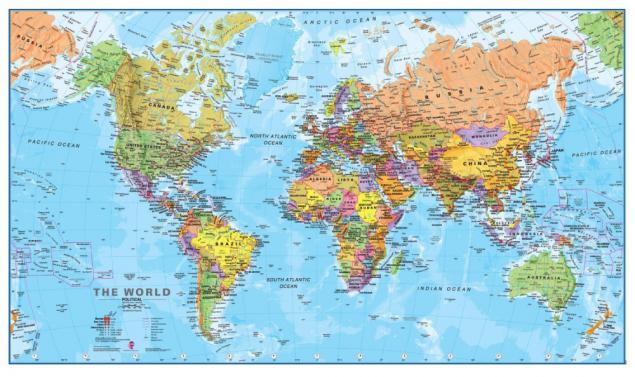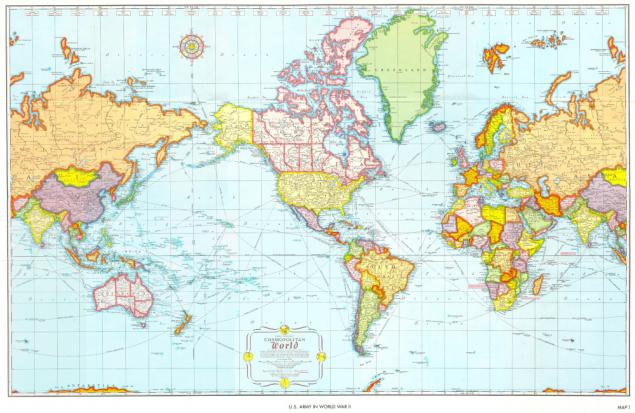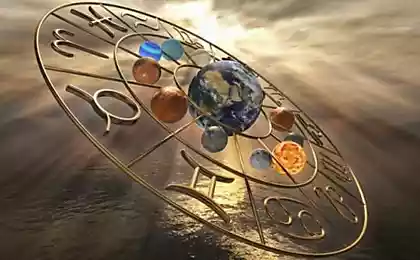1369
Maps of the world - how they look in different countries
Maps of the world that we see with childhood - especially those that show us in school - shape our understanding of how the world works. This would not be anything wrong if we do not forget that the flat map - only conditional and distorted map of the round the world.
However, many of us have learned through the card transfer patterns on a personal relationship to the real world. We begin to believe that there are countries that play a dominant role in the world, are in the center, and there are those who play a subordinate role, are on the periphery.
As will be seen below, in different countries - Russia, Europe, USA, China, Australia, Chile, South Africa - map of the world are very different. It all depends on what the author chooses the cards in each of the following three conditions: 1) how to center the map with respect to the East and West; 2) how to center the map with respect to the North and South; 3) a projection method used.
World map for Rossii
The vertical axis of the world (centering of the West and East) passes through Moscow. Both America and Australia are on the periphery of the world. Pacific is not perceived as an integral space.
World map for Evropy
The vertical axis of the world passes through London. As well as on the Russian map, then the Americas and Australia are on the periphery of the world, and the Pacific Ocean is not perceived as an integral space. In addition, the equator (centering of the North and South) is shifted to the lower half of the card, making Africa, South America and Australia, smaller relative to North America and Eurasia than it actually is.
World map for SSHA
The vertical axis of the world passes through the United States. America is an "island", by the Pacific Ocean to the west and the Atlantic Ocean to the east. As well as on the European map, then the equator is displaced to the lower half of the card, which makes the size of North America and Eurasia, much larger relative to the size of South America, Africa and Australia than it is in reality. In addition, more complicated for the American perception of Russia, India and China: the country on the map, "there" for him twice - in the west and the east.
World map for Kitaya
China on his map is on the western shore of the Pacific Ocean. In this ocean have access to all the continents except Africa and Eurasia, which are thus at the periphery of the world.
World map for Avstralii
There is a common stereotype that dominates what is above and what is below is in a subordinate position. Australians are not only carried out the vertical axis of the world through its mainland, so still and put it on top of the other, turning the card 180 degrees. Like the United States, they are islands lying between the three oceans: the Pacific, Indian and Southern. Another important role is played by the Antarctic, hidden at the bottom on all other cards.
World map for South Afriki
South Africa is similar to Australia is at the top, not the bottom of the card that makes perceive it as a country dominates all others. South Africa is a peninsula, wedged between two oceans: Indian and Atlantic. Pacific and Russia go to the periphery of the world.
World map for Chili
This map of the world has been developed by order of the Military Geographic Institute with the aim of further introduction of school textbooks. Similarly, the Australian map, this is also upside down, so that Chile once dominant position in the world. At the center of the map is the Pacific Ocean, and it is directly related to the policy of sounded modern Chile, who wants to become one of the most important business centers in the Pacific. In this regard, Chile is somewhat similar to China. Similarly, Africa and Europe are on the periphery of her world.
Author: Maxim Karakulov
via medium.com/ karakulov
However, many of us have learned through the card transfer patterns on a personal relationship to the real world. We begin to believe that there are countries that play a dominant role in the world, are in the center, and there are those who play a subordinate role, are on the periphery.
As will be seen below, in different countries - Russia, Europe, USA, China, Australia, Chile, South Africa - map of the world are very different. It all depends on what the author chooses the cards in each of the following three conditions: 1) how to center the map with respect to the East and West; 2) how to center the map with respect to the North and South; 3) a projection method used.
World map for Rossii

The vertical axis of the world (centering of the West and East) passes through Moscow. Both America and Australia are on the periphery of the world. Pacific is not perceived as an integral space.
World map for Evropy

The vertical axis of the world passes through London. As well as on the Russian map, then the Americas and Australia are on the periphery of the world, and the Pacific Ocean is not perceived as an integral space. In addition, the equator (centering of the North and South) is shifted to the lower half of the card, making Africa, South America and Australia, smaller relative to North America and Eurasia than it actually is.
World map for SSHA

The vertical axis of the world passes through the United States. America is an "island", by the Pacific Ocean to the west and the Atlantic Ocean to the east. As well as on the European map, then the equator is displaced to the lower half of the card, which makes the size of North America and Eurasia, much larger relative to the size of South America, Africa and Australia than it is in reality. In addition, more complicated for the American perception of Russia, India and China: the country on the map, "there" for him twice - in the west and the east.
World map for Kitaya

China on his map is on the western shore of the Pacific Ocean. In this ocean have access to all the continents except Africa and Eurasia, which are thus at the periphery of the world.
World map for Avstralii

There is a common stereotype that dominates what is above and what is below is in a subordinate position. Australians are not only carried out the vertical axis of the world through its mainland, so still and put it on top of the other, turning the card 180 degrees. Like the United States, they are islands lying between the three oceans: the Pacific, Indian and Southern. Another important role is played by the Antarctic, hidden at the bottom on all other cards.
World map for South Afriki

South Africa is similar to Australia is at the top, not the bottom of the card that makes perceive it as a country dominates all others. South Africa is a peninsula, wedged between two oceans: Indian and Atlantic. Pacific and Russia go to the periphery of the world.
World map for Chili

This map of the world has been developed by order of the Military Geographic Institute with the aim of further introduction of school textbooks. Similarly, the Australian map, this is also upside down, so that Chile once dominant position in the world. At the center of the map is the Pacific Ocean, and it is directly related to the policy of sounded modern Chile, who wants to become one of the most important business centers in the Pacific. In this regard, Chile is somewhat similar to China. Similarly, Africa and Europe are on the periphery of her world.
Author: Maxim Karakulov
via medium.com/ karakulov
When the lights go out, my room is transformed into a magical world
22 cards for the start of the working year























